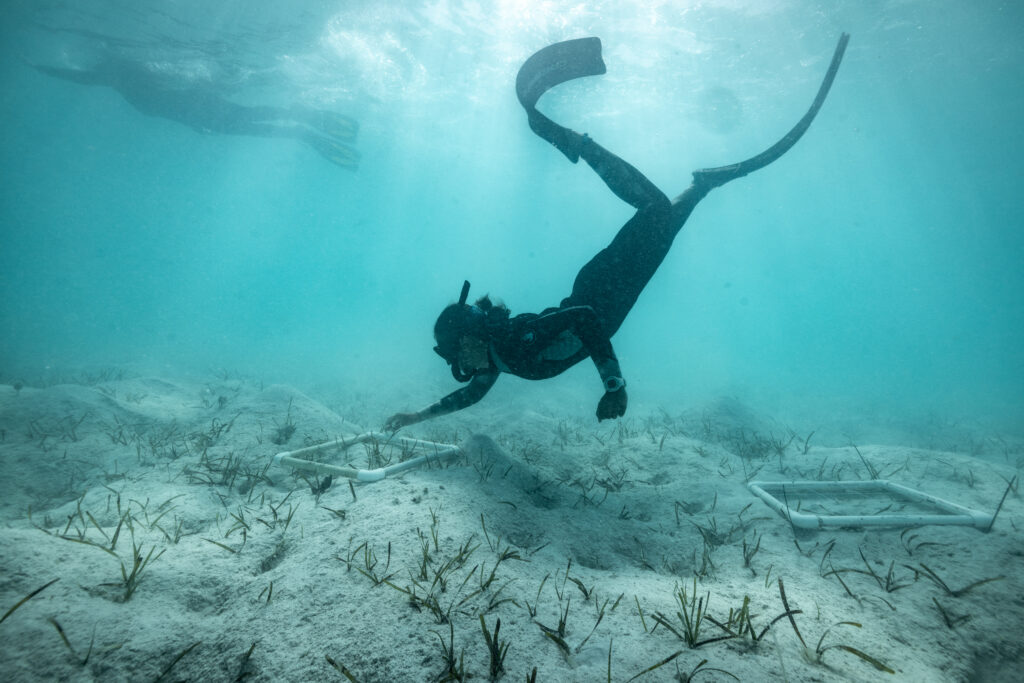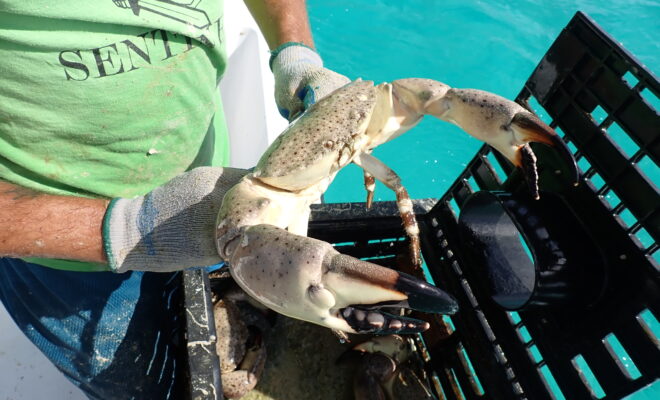In the last few decades, the Bahamian stone crab fishery has grown into an emerging commercial fishery.
With exports of stone crabs claws valued over an estimated $3 million, it is now one of the most valuable export fisheries behind spiny lobster.. The stone crab fishery is unique; it is one of the very few “claw-only” fisheries in the world which only harvests one or both front claws of the crab. The living crab is returned to the sea after harvest. The two front claws, or “biters,” of stone crabs are huge— together, the claws make up as much as 60 percent of their total body weight. These outsized limbs are also very strong, as they have evolved to crush the hard shells of their prey which includes oysters, clams, and other hard-shelled organisms.
Although crabs have the incredible ability to regrow any limbs they lose, the loss of their claws will, at best, change their behavior and their ability to eat, and at worst, can kill the crab shortly after harvest. Because of the growing importance of this fishery in The Bahamas, researchers at the Cape Eleuthera Institute (CEI) have been working to better understand the effects of this fishery, both on the crabs it harvests and the habitats it operates in. This work ensures that stone crab will continue to be an abundant resource in The Bahamas for future generations.
Read more about CEI’s groundbreaking new harvest method to increase crab survival here, or searching “Don’t clip the biter, stick it!”


| To study the impact of stone crab traps, researchers survey the surface of the seafloor in the affected area (left) then take a sediment sample (right). The process is repeated at a nearby control site. |
the environmental impacts of the stone crab fishery
Like other crustacean fisheries, stone crabs are caught in traps that sit on the seafloor. Until recently, these crab traps and other static fishing gears were considered to have little to no impact on the plants and animals living on the seafloor (also called benthic communities). However, new research shows that some kinds of this static fishing gear can cause serious damage to the benthos.
The environmental impacts of stone crab traps in particular have not yet been studied. This is concerning since these traps have a solid cement bottom, making them heavier than traps used in most other crustacean fisheries and increasing the potential for crushing animals or depriving marine plants of sunlight and oxygen. As fishing for stone crabs becomes more common, it’s important to understand the impacts of fishing before any negative impacts become widespread.
During meetings held by CEI and the Perry Institute of Marine Science (PIMS), local stone crab fishers have mentioned moving traps frequently to avoid harming the seafloor and expressed concern for what effect their traps may be having on benthic communities. Current research at CEI aims to address these concerns by studying the plant and animal life under traps. These organisms are compared to those in areas of the seafloor where traps have not been deployed to determine if the traps reduce the number or diversity of living things. This is done by surveying the seafloor after traps have been removed to identify and record any plants or animals in the area, then taking a small sediment sample, which is later searched for invertebrates like worms, clams, snails, and brittle stars.
Though this research is still in progress, it will shed light on whether stone crab traps are harming benthic organisms and whether moving traps frequently, as some fishers already do, can reduce or eliminate any negative effects. As the fishery continues to expand, such knowledge will help inform best practice to ensure the fishery is sustainable not only for stone crabs, but for all the other organisms with which they share their ecosystems.
